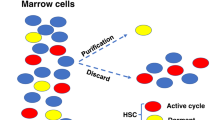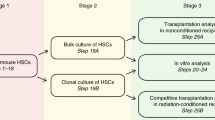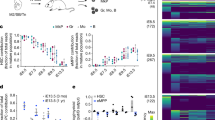Abstract
HAEMOPOIETIC stem cells, characterized by their ability to differentiate and reproduce themselves, are believed to be precursors of all differentiated blood cells in the organism. During embryogenesis, they are presumably present in the yolk sac, liver, spleen and marrow—the successive sites of erythropoiesis. The stem cells may be derived from a common source or they may arise independently in each site during development. If they are not indigenous to the erythropoietic organ they may be either transported from one site to another through the peripheral blood1 or incorporated into the developing organ in tissues shared by the previous erythroid site2,3.
This is a preview of subscription content, access via your institution
Access options
Subscribe to this journal
Receive 51 print issues and online access
$199.00 per year
only $3.90 per issue
Buy this article
- Purchase on Springer Link
- Instant access to full article PDF
Prices may be subject to local taxes which are calculated during checkout
Similar content being viewed by others
References
Moore, M. A. S., and Owen, J. J. T., Lancet, ii, 658 (1967).
Wilson, C. V., Groat, C. S., and Leduc, E. H., Ann. NY Acad. Sci., 11, 8 (1963).
Barker, J. E., thesis, Univ. Wisconsin (1967).
Till, J. E., and McCulloch, E. A., Radiat. Res., 14, 213 (1961).
Goodman, J. W., and Hodgson, G. S., Blood, 19, 702 (1962).
Hanks, G. E., Nature, 203, 1393 (1964).
Hellman, S., Nature, 205, 100 (1965).
Barnes, D. W. H., and Loutit, J. F., Lancet, ii, 1138 (1967).
Southard, J. L., Wolfe, H. G., and Russell, E. S., Nature, 208, 1126 (1965).
Dulbecco, R., and Vogt, M., J. Exp. Med., 99, 167 (1954).
Barker, J. E., Keenan, M. A., and Raphals, L., J. Cell. Physiol., 74, 51 (1969).
Ford, L. C., Donaldson, D. M., and Allen, L. A., Proc. Soc. Exp. Biol. Med., 127, 206 (1968).
Hanna, jun., M. G., Nettesheim, P., Fisher, W. D., Peters, L. C., and Francis, M. W., Science, 157, 1458 (1967).
Labardini, J., Sanchez-Medal, L., Arriaga, L., Lopez, D., and Smyth, J. F., J. Lab. Clin. Med., 72, 419 (1968).
McCulloch, E. A., Siminovitch, L., and Till, J. E., Science, 144, 844 (1964).
Moore, M. A. S., and Metcalf, D., Brit. J. Haematol., 18, 279 (1970).
Fantoni, A., De La Chapelle, A., Rifkind, R. A., and Marks, P. A., J. Mol. Biol., 33, 79 (1968).
Author information
Authors and Affiliations
Rights and permissions
About this article
Cite this article
BARKER, J. Embryonic Mouse Peripheral Blood Colony-forming Units. Nature 228, 1305–1306 (1970). https://doi.org/10.1038/2281305a0
Received:
Revised:
Issue Date:
DOI: https://doi.org/10.1038/2281305a0
This article is cited by
-
Chimaerism and erythroid marker expression after microinjection of human acute myeloid leukaemia cells into murine blastocysts
Oncogene (2003)
-
Effect of some cytostatics on the haemopoietic stem cells (CFUs) in blood
Cancer Chemotherapy and Pharmacology (1979)
Comments
By submitting a comment you agree to abide by our Terms and Community Guidelines. If you find something abusive or that does not comply with our terms or guidelines please flag it as inappropriate.



